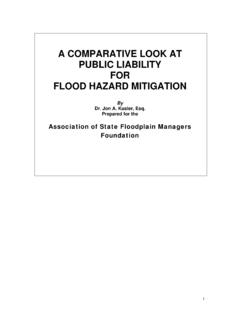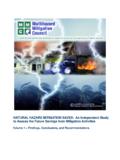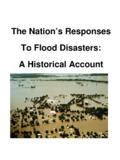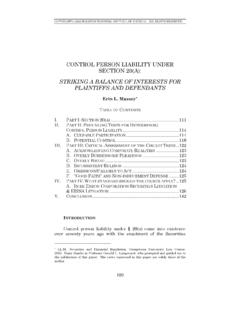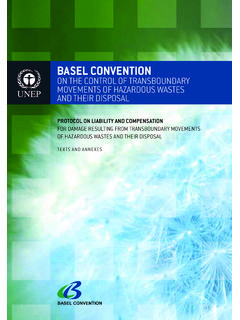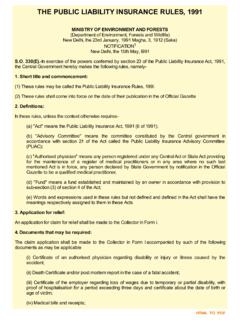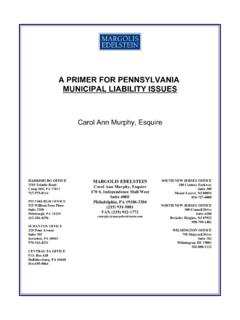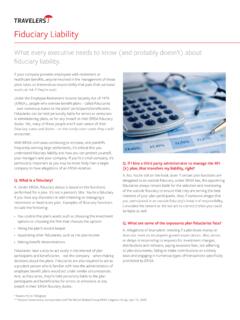Transcription of OWNER’S LIABILITY FOR DAM FAILURE DUE TO FLOODING
1 LIABILITY FOR WATER control STRUCTURE FAILURE DUE TO FLOODING Edward A. Thomas, Esq. Michael Baker, Inc. Challenge Us Association of State Floodplain Managers Produced in Support of the Annual Meeting of The Floodplain Management Association September 7, 2006 -2- Preface This paper is a pro bono effort of the author, sponsored by Michael Baker, Inc., the Association of State Floodplain Managers, and the Flood control District of Maricopa County.
2 The opinions contained in the paper are the author s and do not necessarily represent the views of any organization or company. Sam Riley Medlock, CFM, a student at Vermont Law School, provided legal research, updated material, and assistance with image credits for this 2006 edition with financial support from the Association of State Floodplain Managers. This paper is based on general principles of law. It is not legal advice. For legal advice please consult an attorney licensed to practice in your jurisdiction. This paper is designed to provide both a laypersons overview of the law concerning the LIABILITY for the FAILURE of major Water control Facilities such as Dams and Levees; and to provide guidance which will assist Attorneys in conducting legal research in this area of the law.
3 I. Summary This paper will examine the standards used by courts in the United States to assess LIABILITY for damage due to the FAILURE of a flood control structure. As used in this paper, flood control structure includes dams, levees, and other major non-natural structures that store, divert, or transport large volumes of water. Determining who will pay for such damage involves a fundamental conflict between two of the most important beneficial incidents of land ownership: the right of exclusive occupation and the right of utilization. The owner of the land on which the flood control structure is situated desires to utilize fully his or her land, and often to help provide beneficial services such as flood control and water supply to the community.
4 The damaged property owner wishes to exclusively occupy and enjoy her land without serious injury from adjacent property owners. Either right carried to an extreme requires one owner to surrender valuable property rights to the other. The legislature or the courts must draw a line between each party s property rights in such a way as to fairly reconcile their -3- conflicting desires. Exact placement of that boundary line between the property rights of owners will be a reflection of existing social, political, and economic conditions that prevail in society. John Rylands (1801-1888), owner of the Ainsworth Mills, Lancashire, UK, whose impoundment flooded his neighbor s mine, giving rise to the concepts of dangerous accumulations, escape of same, and LIABILITY without fault.
5 Image credit: John Rylands University Library, Manchester, UK. Early English Common Law established a boundary line that greatly favored protecting the adjacent property owner from damage by someone who had caused an artificial change in the flow of water. Later, some jurisdictions in the United States modified this doctrine to hold that a water control facility owner would only be liable for damage resulting if the facility failed if the plaintiff could demonstrate that there was a lack of due care in building or maintaining the water control structure. Today, virtually all states impose some form of strict LIABILITY on owners of water control structures that cause harm to others even if the owner utilized utmost care.
6 II. English Common Law Early English Common Law held that a person was absolutely responsible for any damage resulting from his actions regardless of intent or Absolute LIABILITY supported two important goals of the law: It discouraged dangerous conduct2 and placed the burden of paying damages on the party who caused the The Industrial Revolution placed a premium on the encouragement of commercial and industrial activity. The concept of strict LIABILITY was considered an impediment to 1 See, , Anonymous, Edw. IV F.
7 7 pl. 3 ( 1466) where Justice Brian stated .. if a man commits an assault on me and I cannot avoid I lift my stick in and there is a man in back of me and I injure him in lifting my stick in that case he would have an action against me, although my lifting the stick was lawful to defend myself and I injured him with-out intent. 2 James, Accident LIABILITY Reconsidered: The Impact of LIABILITY Insurance, 57 Yale 549 (1948) [hereinafter cited as James]. 3 See, , Lambert v. Bessey, 83 Eng. Rep. 220 ( 1681). -4- commercial and industrial activity. As the Industrial Revolution swept through England, the courts gradually developed the concept that if there was no fault4 on the part of the party who caused the harm then there should be no payment of damages to the injured party.
8 In this manner a transition was made to a standard of negligence for most conduct between two parties where one suffered damage as a result of the other s At the same time that the concept of negligence was developing, the landmark case of Rylands v. Fletcher was One commentator has observed that perhaps no case in history has occasioned more controversy and Briefly stated, the facts of the case are that a mill owner constructed a dam to obtain water power. The site of the water reservoir created by the dam was riddled with abandoned and blocked-up mine shafts. These shafts connected to active mine workings on an adjacent property.
9 Ten days after the reservoir was filled, water broke through the abandoned shafts and caused serious flood damage to the mine on the adjacent property. If the water had poured directly into the adjacent mine shaft rather than coming to rest for ten days, the English courts would have found that a trespass had taken place. Had the water slowly seeped into the mines, the English courts would have found this to be an abiding nuisance. The mill owner would have been liable for the damage caused in either There is a clear indication in Rylands that the contractor who built the dam was aware of the abandoned mine shafts in the area where the reservoir would be and was negligent in going forward with the construction nevertheless.
10 However, Common Law did not yet recognize the principal that an employer might be held liable for the 4 For the purposes of this article the term fault means legal fault. Moral fault is not significant to this article. See, W. Prosser, The Law of Torts 18 (1971) for a discussion of the subtle difference between moral and legal fault. 5 See, Sheldon, Return to Anonymous: The Dying Concept of Fault, 25 Emory 163, (1976) [hereinafter cited as Sheldon]. 6 159 Eng. Rep. 737 (Ex. 1865), rev d, 1 Ex. 265 (1866), aff d, 3 330 (1868).
